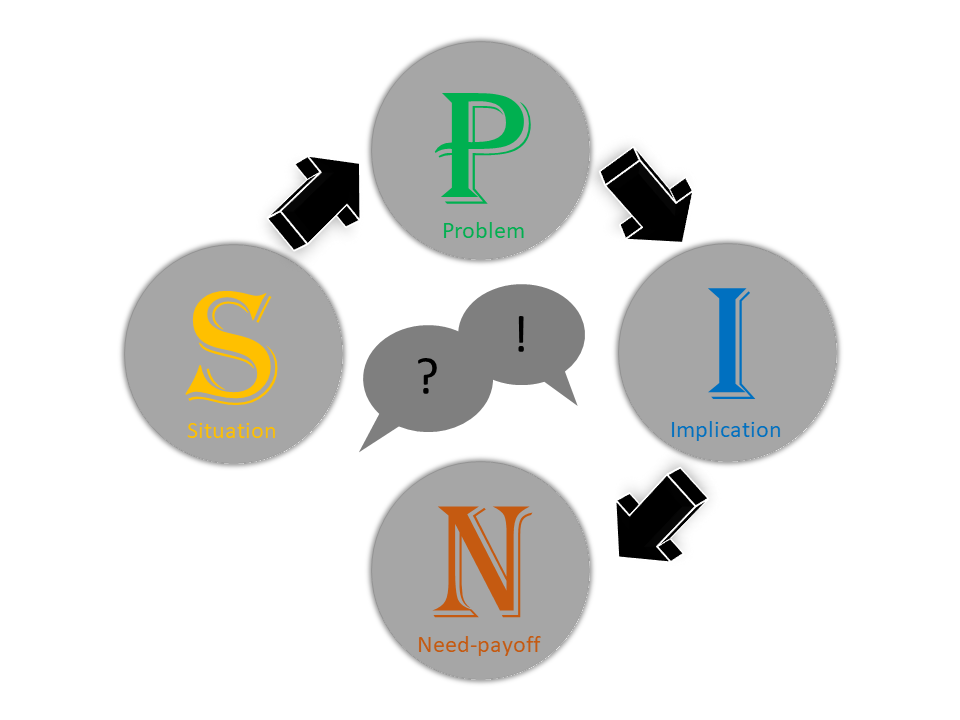The true potential of SPIN Questions and how to adapt them

Utilising SPIN questions is a selling technique which was developed by Neil Rackman in 1988 (European Sales Competition Manual 2020, 28). The objective is to gain a better understanding of customer needs in an interactive way as well as building more loyal customer relationships. The SPIN Questions are a powerful tool, which is based on asking the right questions in the right order, while actively listening and transferring the needs/problems of the customer into the features of the product. By asking many open questions, the goal is to make the other person think and show them a solution to their problem. SPIN is an abbreviation of the following terms: Situation, Problem, Implication and Need-payoff.

Situation
The seller uses situation questions in a sales meeting to establish a context of the customer. The aim is to build up a foundation on which the other questions can be developed on. It is also about using these simple questions to put the other person in a positive stance and focus on the next questions. The situation questions should be kept to a minimum, since the salesperson researched the costumer during the preparation for the meeting. They can help the seller to get further information about processes, customers or tools of the prospect’s company.
Examples: (European Sales Competition Manual 2020, 29)
- Who is involved in the decision-making process in your project?
- How is your current offer situation in comparison to your competitors?
- How many employees work the project?
Problem
The salesperson can then move on to asking problem uncovering questions. These can also include different types of difficulties and dissatisfaction regarding the product or service. Utilising problem questions is an effective way to better interaction between a salesperson and customer. With the problem questions it is about getting a lot of info from the buyer about his problem. These questions are often a bit uncomfortable, but they help to bring the buyer into a state that makes him realise that he must change something and, in the best case, motivate him to buy. Focusing on open questions, the salesperson can learn which specific factors are causing crossroads and complexities to the customer.
Examples: (European Sales Competition Manual 2020, 29)
- What kind of difficulties are you facing in your company right now?
- How satisfied are you with the price-performance ratio?
- What makes the operation challenging/difficult?
Implication
Implication questions are useful to make the customer realise the significance and magnitude of the problem he is facing. The depth of the prospect’s pain point will be obvious and furthermore, the salesperson will get valuable information for customising his message and communicating the urgency to the buyer. They also reveal the possible consequences for the customer if the problems are not being solved. Implication questions are especially useful when the interlocutor is a decision maker whose success depends on solving these problems and understanding its cause.
Examples: (European Sales Competition Manual 2020, 29-30)
- What effect do these problems have on your performance?
- How would delivery delays affect your project?
- Could this lead to increased costs?
Need payoff
Need-pay-off questions regarding the usefulness of a future solution. This also means questions about the value and importance of solutions. It’s about getting the customer to think for themselves about how the solution might help them. As a seller, you don’t have to talk much about the benefits of your product, because the buyer is already convinced that the solution is valuable to him. This step will have a large influence on finding out how much the customer is willing to pay for the product.
Price is what buyers pay; value is what they receive.
Examples: (European Sales Competition Manual 2020, 30)
- Why is it important to solve this problem?
- How helpful is it for you?
- What benefits do you see?
Why should you use the SPIN Questions for your sales? Often buyers are tired of long product presentations. In order not to bore your customers and to stand out from the crowd, it makes a lot of sense to use SPIN Questions. And not only that: you understand your customer very well through the questions and work out in this conversation a customised way to an individual solution for your customer with which you both agree. As if that wasn’t enough, you also use a powerful psychological tool, because through the many questions it feels to the customer that he himself has put a lot of work into the development of the idea. This helps you as a salesperson not only to close more sales, but also build up more lasting and stronger customer relationships.
Authors: Nguyet Huynh, Heinrich Herwig, Lee Sauer
